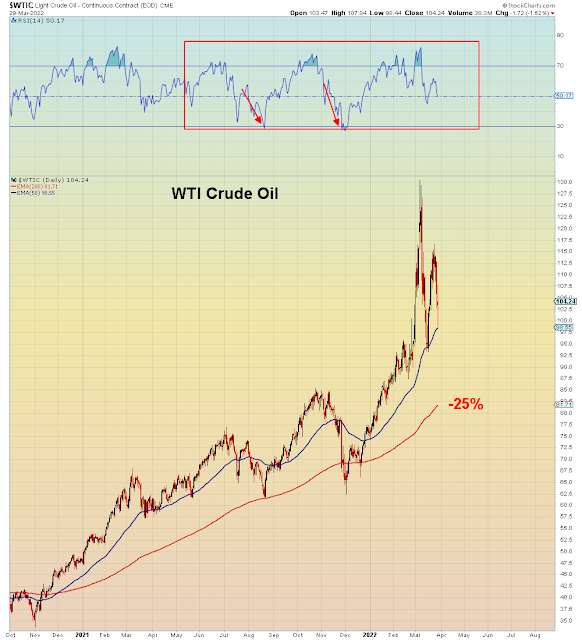In this post I will focus on the commodity markets and the prospects for imminent crash which would be extremely deflationary...
This linked article makes the case that $150/bbl oil is still likely. Let's tackle the bullish argument before we get to the bearish points. The bullish argument is based upon the fact that the global spot oil market is extremely "tight" meaning there is no excess supply. So tight that the market is in backwardation meaning spot prices are higher than future prices, which is extremely unusual. The other part of the bullish argument assumes that Europe will ban Russian oil and therefore global supply will tighten further. These are the exact same arguments that were used prior to the war. In the months prior to the war, oil was trading in a very wide range between $60 and $90. Volatility was extremely high. When the invasion began, oil sky-rocketed from $100 to $130 in a matter of days. In other words, those who are piled into commodity trades and waiting for the melt-up should be aware that it ALREADY took place.
On the chart below on the left side we see the post-Crimean war collapse. Followed by the China/Fed policy error collapse. In the middle the 2018 Fed policy error crash followed by pandemic. As we see, realized volatility is at a record. The lower trend-line is -50% lower from high to low.
Does anyone remember August 2014? (see circle with "Crimea"):
“I’ve been surprised at the market and have actually taken a loss on Brent and North Sea crude,” he said. “It seems like the world has accepted war in the Middle East. After a while investors say: ‘OK, that’s the way it’s going to be,’ and production hasn’t been cut off any place.”
That $100 prediction didn't last two weeks.
So we see this is all very deja vu, nevertheless I will tackle these fundamental arguments:
First off, the tight spot oil market and backwardation are very likely a short-term phenomenon. The futures market is clearly expecting oil to decline. In addition, if there is a global recession, which appears highly likely, demand will fall. At the same time, supply will adjust to the higher prices and reach market at a time when demand is falling.
We have seen this OVER and OVER again during the past decade. Supply adjusts at the worst possible time.
This chart shows all of the recent times the oil market was in backwardation meaning the USO ETF (futures-based) was gaining value as it approached the spot (front-month) expiration. Each time USO/WTI rose, the market collapsed:
This chart shows that from a global growth perspective commodities diverged the most from China GDP in 20 years. The last divergence in 2014 resolved to the downside to the surprise of T. Boone Pickens.
The second bullish argument is that soon Europe will ban Russian oil imports. We've heard this many times before. The Germans have recently said that won't happen BEFORE the end of this year.
"Germany, the continent’s biggest economy, still gets 40 per cent of its gas from Russia, even after cutting its reliance.
It aims to end Russian coal imports this summer, oil imports by the year's end, and be largely independent on gas by 2024, German Economy Minister Robert Habeck said"
Just this week, German bankers warned that cutting off oil and gas imports will cause a deep recession:
Those are the bullish arguments, now here come the bearish ones:
Every commodity shock since 1970 led to a U.S. recession - 1973, 1980, 1990 (Gulf War), 2008.
Now, both the Fed AND European central banks are in a box. They can't ease policy until they see major economic and financial dislocation. European inflation is running at record levels:
"there are other side-effects from the war, most notably higher energy prices — which are driving up inflation across the bloc. European Central Bank President Christine Lagarde said earlier this week that “three main factors are likely to take inflation higher” going forward"
The global economy cannot AFFORD higher energy prices. Because the current prices are already driving a far too rapid monetary tightening.
In addition, the dollar is now heading higher into the upcoming FOMC:
Last but not least, the International Energy Agency today announced that they will join the U.S. in releasing oil from their strategic reserves:
"Between the IEA and the United States, 240 million barrels of crude oil is set to be released from the world’s strategic energy stores"
The U.S. release of 180 million barrels will be the equivalent of 1/3rd Russian production for the next six months. However, Russian production is still likely to reach the market.
Here we see what happened the last time the U.S. released oil from the SPR - it crashed. This time it's far more technically at risk of...
Margin call.
In summary, it's HIGHLY likely we are on the verge of a massive deflationary commodity crash. And when that happens along with the coincident crash of real estate and stocks, everyone will realize that inflation is no longer the problem.





















































